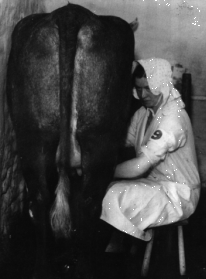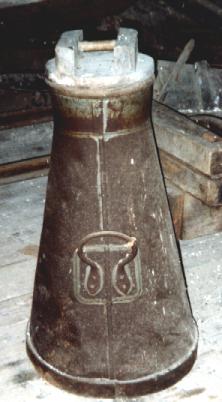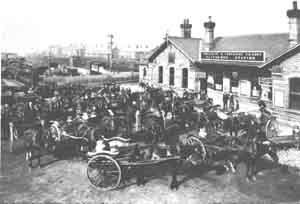Dairy Equipment

Most hill-district farms kept a cow or two who gave enough for the family to use themselves. Some mixed farms also kept milk cows, so they could sell milk or other dairy products. Dairy farms were commoner on the better land of the Eden Valley and the Solway Firth.
Hand Milking
The dairymaid milked the cow by hand, sitting on a three-legged stool or "coppy" with one ear tucked against the cow's flank while she worked.
This young lady was taking part in a "Clean Milk Competition". These were promoted by Newton Rigg Farm School and Armstrong College in the 1930s. The idea was to improve the keeping qualities of the milk produced on local farms.
In 1945-46 on North Country farms, a cow averaged 573 gallons of milk per year. (King's College Report 1945-46, quoted in "Seeds of Change".)

Once she had finished milking the cow, the dairymaid carried the milk in milk pails to the churn.
These metal pails are fairly recent. They were enamelled to give a good smooth surface which did not hold the bacteria that could sour the milk. Earlier pails were made of wood and needed daily scouring to keep them sweet.

John Gate remembers: "You’d a number on the side, on a brass plate, and folk used to polish them, they’d compete, who’d the smartest milk tin."
Churns and Competitions

Churns were used to store the milk for later use. In the 1950s, these churns stood out on milk stands at the gates of farms ready for collection by the milk wagon that would take the milk to the depot for pasteurisation and bottling. In summer a conscientious farmer would make sure that he didn't put the churns out until the wagon was about due, since there was no means of keeping the contents cool once out in the sun. However, churns due for very early collection were often stood out in the late evening and cooled all night.
Before the days of collection by the milk wagon, farmers took their churns to the railway station to load them onto the train to the nearest town.
Right: This is Clitheroe Railway Station in Lancashire, where over 40 farmers and horsedrawn farm floats used to wait to load the early morning "milk train".